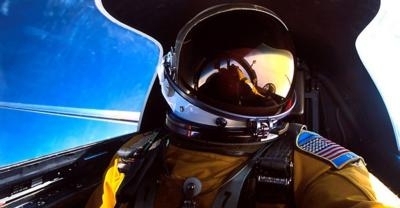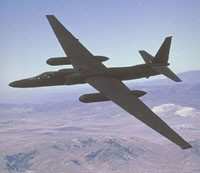Iconic Spy Plane Has Been Flying For 50 Years, Has Plenty Of Life Left
Whether people recognize it by the Snoopy-like nose or by the flat black paint and red lettering on the tail, the U-2 has become an Air Force reconnaissance icon in its 50 years of military operations. Since the first model was assembled in the 1950s, the aircraft's original, shiny aluminum skin has evolved to the current flat black paint scheme, and its mission has broadened as intelligence imagery techniques have improved.

It was originally designed to fly high-altitude intelligence, surveillance and reconnaissance missions during the Cold War to gather intelligence on opposition forces. Today the U-2S flies in support of a variety of missions from ground combat to disaster relief. The aircraft has been updated over the years with a 33 percent larger frame, fiber-optic wiring and an all glass cockpit. These improvements increase the aircraft's payload and loiter time, making it easier to fly.
The U-2's dynamic airframe can carry approximately 4,000 pounds of equipment, paving the way as a test platform for new technologies. With its immense and diverse payload capacity, it is capable of a multitude of missions. Some pilots describe it as the "Lego" airplane. "It's like Mr. Potato Head," said Lt. Col. John, an instructor pilot with the 99th Reconnaissance Squadron. "You just take one part out and add a new one. There are so many new developments running through the works right now. New weapons systems are going to emerge and accelerate the curve of the U-2 even more."
One of the aircraft's primary missions is to capture imagery via the decades-old, wet-film camera, which is sharp enough to see roadside bombs from 70,000 feet and offers greater resolution than any digital sensors available. "The U-2 started out only carrying a wet-film camera. Now, with today's technology, I'm alone up there, but I may be carrying 40 to 50 Airmen via data link who are back at a (deployable ground station)," John said.
In addition to its other capabilities, the U-2 provides service members on the ground with the intelligence they need to effectively carry out their mission, said Capt. Michael, a 1st Reconnaissance Squadron instructor pilot. This could include acting as an antenna to troops on the ground in Afghanistan or providing detailed imagery during a natural disaster. "We are up there to make a difference," Michael said. "We are there to make an impact on the troops we support."

For operational security reasons, many details about the U-2 and its mission are unknown to the public. When the airframe was in its infancy, even pilots coming into the program knew very little about it. One of those men is retired Lt. Col. Tony Bevacqua, one of the original Air Force U-2 pilots. Since the jet was developed at the height of the Cold War, it was used extensively over the Soviet Union, Cuba, and other opposition countries. Bevacqua said every precaution was taken to keep the technology from leaking into enemy hands. "I volunteered for an assignment I knew nothing about, and they wouldn't tell me anything about the U-2," Bevacqua said. "The aircraft was state-of-the-art back then; no one in the public knew about it."
This first class of pilots had to learn everything about the aircraft from the ground up. They developed the first U-2 training program in a matter of weeks, much of which is still used today. "Before I joined the Air Force, I'd never even built a model airplane, but we trained hard to learn everything about the U-2," he said. "After weeks of being the first pilots in the U-2, we became the instructors for the second class of pilots."
The program is considered an exclusive group, with less than 80 current U-2 pilots. "There are more people who have Super Bowl rings than there are U-2 pilots," said Lt. Col. Stephen Rodriguez, the 1st Reconnaissance Squadron commander. "There are less than 1,000 pilots in the history of this program. That's less than some airframes train in one year."
The U-2 is at a high operational tempo and with the program schedule to endure through 2040, there are no signs of slowing down. U-2 pilots will continue to provide timely, relevant and persistent high altitude ISR to meet the needs of the nation's leaders to support the current fight and any future challenges our nation may face.
ANN Salutes Senior Airman Shawn Nickel
 ANN's Daily Aero-Term (04.30.24): Runway Centerline Lighting
ANN's Daily Aero-Term (04.30.24): Runway Centerline Lighting ANN's Daily Aero-Linx (04.30.24)
ANN's Daily Aero-Linx (04.30.24) Airborne 04.24.24: INTEGRAL E, Elixir USA, M700 RVSM
Airborne 04.24.24: INTEGRAL E, Elixir USA, M700 RVSM Airborne 04.29.24: EAA B-25 Rides, Textron 2024, G700 Deliveries
Airborne 04.29.24: EAA B-25 Rides, Textron 2024, G700 Deliveries Airborne-NextGen 04.23.24: UAVOS UVH 170, magni650 Engine, World eVTOL Directory
Airborne-NextGen 04.23.24: UAVOS UVH 170, magni650 Engine, World eVTOL Directory




